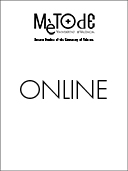Arguing to convince: The rhetoric of scientific discourse
DOI:
https://doi.org/10.7203/metode.6.4615Paraules clau:
Retórica. Retoricidad. Discurso retórico. Discurso científico. Argumentación. Resum
Resum
This paper deals with scientific discourse as a rhetorical discourse from the point of view of the structure of the classical parts of oral discourse (and all kinds of discourse). The role of argumentation in discourse, with the perlocutionary goal of convincing the receiver, is studied as the foundation of the rhetorical nature of scientific discourse. A scientific treatise by Santiago Ramón y Cajal is analysed using the tools provided by rhetoric in order to prove the rhetorical nature of scientific discourse. The main contribution of this paper is to establish the crucial role of argumentation in scientific discourse and to demonstrate its permeation of the entire discourse.
 Descàrregues
Descàrregues
 Referències
Referències
Albaladejo, T. (1988-1989). Semántica y sintaxis del texto retórico: inventio, dispositio y partes orationis. Estudios de Lingüística Universidad de Alicante, 5, 9–15.
Albaladejo, T. (2013). Retórica cultural, lenguaje retórico y lenguaje literario. Tonos. Revista de Estudios Filológicos, 25. Retrieved from http://www.um.es/tonosdigital/znum25/secciones/estudios-03-retorica_cultural.htm
Arduini, S. (2007). Metaphors concepts cognition. In S. Arduini (Ed.), Metaphors (pp. 7–16). Rome: Edizioni di Storia e Letteratura.
Aristóteles. (1971). Retórica. Madrid: Instituto de Estudios Políticos. Chico Rico, F. (2015). La traducción del texto filosófico: Entre la literatura y la ciencia. Castilla. Estudios de Literatura, 6, 94–112. Retrieved from http://www5.uva.es/castilla/index.php/castilla/article/view/422
García Berrio, A. (1984). Retórica como ciencia de la expresividad. Presupuestos para una Retórica General. Estudios de Lingüística Universidad de Alicante, 2, 7–59.
Hernández Guerrero, J. A., & García Tejera, M. C. (2004). El arte de hablar. Manual de retórica práctica y de oratoria moderna. Barcelona: Ariel.
Lausberg, H. (1966-1968). Manual de retórica literaria. Fundamentos de una ciencia de la literatura. Madrid: Gredos.
Marraud, H. (2007). Methodus argumentandi. Madrid: Ediciones de la UAM.
Ordóñez, J. (1998). Sobre la persuasión en la ciencia: Cómo se puede explicar lo que se ve. Retórica hoy. Teoría/Crítica, 5, 281–292.
Pera, M. (1991). Scienza e retorica. Rome – Bari: Laterza.
Pujante, D. (2003). Manual de retórica. Madrid: Castalia.
Quintiliano, M. F. (1970). Institutio oratoria. Oxford: Oxford University Press.
Ramón y Cajal, S. (1921). Las sensaciones de las hormigas. Madrid: Real Sociedad Española de Historia Natural. Retrieved from http://cvc.cervantes.es/ciencia/cajal/cajal_articulos/hormigas.htm
Real Academia Española. (2014). Ciencia. In RAE (Ed.), Diccionario de la Lengua Española. Madrid: RAE – Espasa.
Salvador Liern, V. (2008). Applied rhetoric and stylistics in Spain and Portugal in the 20th and 21st centuries. In U. Fix, A. Gardt, & J. Knape (Eds.), Rhetorik und stilistik/rhetoric and stylistics. Ein internationales handbuch historischer und systematischer forschung. an international handbook of historical and systematic research (pp. 532–550). Berlin – New York: De Gruyter.
Zamora Bonilla, J. P. (2006). Rhetoric, induction, and the free speech dilemma. Philosophy of Science, 73, 175–193.
Descàrregues
Publicades
Com citar
-
Resum1587
-
PDF 512
Número
Secció
Llicència
![]()
Tots els documents inclosos en OJS són d'accés lliure i propietat dels seus autors.
Els autors que publiquen en aquesta revista estan d'acord amb els següents termes:
- Els autors conserven els drets d'autor i garanteixen a la revista el dret a la primera publicació del treball, llicenciat baix una llicència de Reconeixement-NoComercial-SenseObraDerivada 4.0 Internacional de Creative Commons, que permet a altres compartir el treball amb un reconeixement de l'autoria del treball i citant la publicació inicial en aquesta revista.
- Es permet i s'anima els autors a difondre la versió definitiva dels seus treballs electrònicament a través de pàgines personals i institucionals (repositoris institucionals, pàgines web personals o perfils a xarxes professionals o acadèmiques) una vegada publicat el treball.





